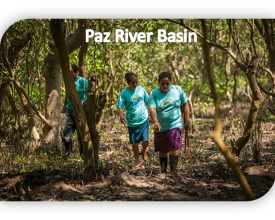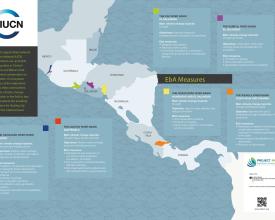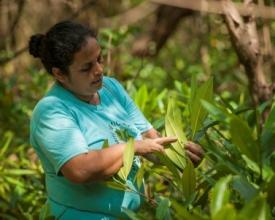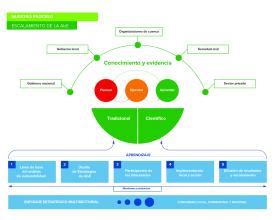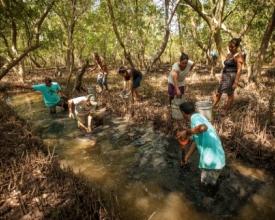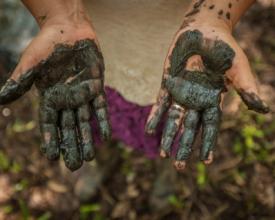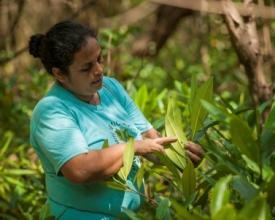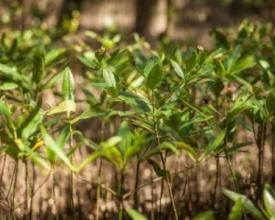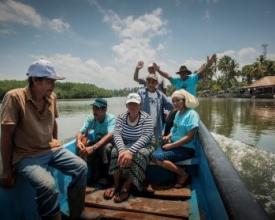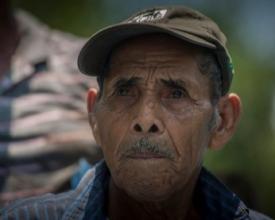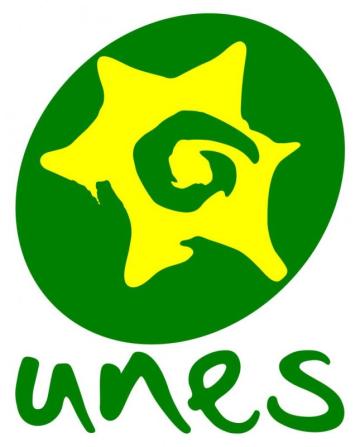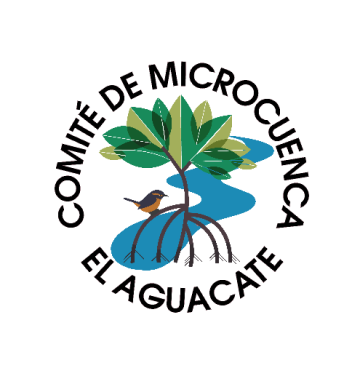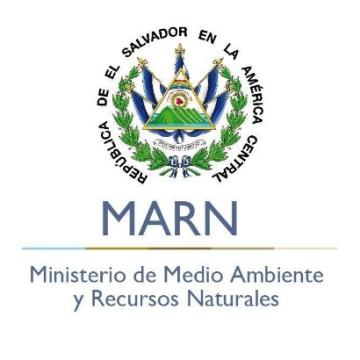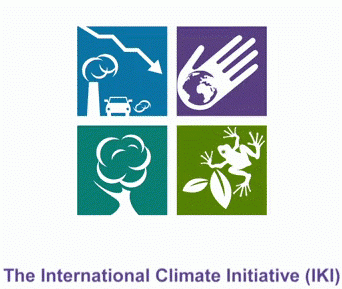
Renforcement du leadership communautaire pour la restauration de la mangrove et la sécurité alimentaire de la rivière Paz, El Salvador
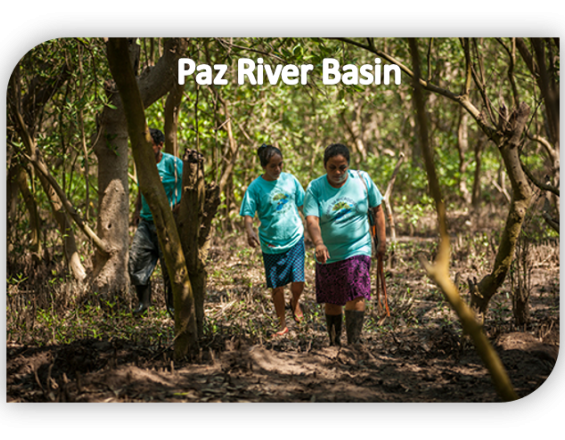
L'hydrodynamique et le cours de la partie inférieure de la rivière Paz ont été modifiés dans le passé, ce qui a affecté l'approvisionnement en eau de l'embouchure de la rivière et des mangroves côtières. Actuellement, la dégradation se poursuit en raison de la déforestation et des pratiques agricoles telles que la culture de la canne à sucre et l'élevage. Ces activités mal gérées ont conduit à une utilisation inéquitable de l'eau douce et à des conflits entre les entreprises, les communautés et les autorités locales. Les communautés et les écosystèmes côtiers de Garita Palmera sont parmi les plus touchés.
Après avoir évalué la diminution des débits d'eau et la vulnérabilité de leurs moyens de subsistance, les familles de pêcheurs ont accepté de mettre en œuvre des mesures d'adaptation basées sur les écosystèmes (EbA) pour restaurer les forêts côtières et les mangroves avec le soutien de l'ONG Unidad Ecológica Salvadoreña et de l'UICN. Ces mesures ont permis de sensibiliser à l'importance des services écosystémiques et d'améliorer leur état grâce à des accords de conservation, à la restauration et au suivi communautaire.
Solution développée dans le cadre du projet AVE - www.iucn.org/node/594
Contexte
Défis à relever
Les risques climatiques liés à l'eau dans la région sont les suivants
- Risque d'inondation dans la plaine côtière
- Les scénarios climatiques prévoient une diminution des précipitations et une augmentation des sécheresses.
- Diminution de la disponibilité des ressources en eau
Les défis liés à la production durable et à la gestion des bassins versants sont les suivants :
- Les facteurs de déforestation dus à l'introduction de la canne à sucre et du bétail.
- Pratiques d'irrigation non durables des producteurs de canne à sucre
- Les puits d'eau (aquifères) et la qualité de l'eau des écosystèmes de mangrove sont de plus en plus salinisés.
- L'érosion des sols et les problèmes de pollution dus aux pratiques agricoles.
En ce qui concerne la gouvernance des ressources naturelles, d'autres défis importants sont à relever :
- Le Salvador ne dispose pas d'un cadre réglementaire spécifique pour la gestion intégrée des bassins versants ou des ressources en eau.
- Il n'existe pas d'instruments de gestion des terres qui permettraient d'améliorer la gestion en amont afin de garantir la disponibilité de l'eau en aval.
- En outre, le bassin de la rivière Paz est partagé entre le Salvador et le Guatemala, ce qui nécessite une coordination binationale.
Emplacement
Traiter
Résumé du processus
Cette solution envisage 3 Building Blocks (BB) : La gouvernance de l'eau (BB3) et la mise en œuvre des mesures EbA (BB2) sont réalisées en mobilisant le soutien des structures communautaires existantes dans le cadre d'une approche "d'apprentissage par l'action" (BB1) qui combine la formation, les actions sur le terrain, la participation, le suivi et l'évaluation des services écosystémiques. Au niveau communautaire, un processus d'apprentissage collectif et d'autonomisation est généré par l'acquisition de connaissances sur la vulnérabilité, la restauration des écosystèmes en tant que mesure d'EbA, la sécurité alimentaire et hydrique et les cadres juridiques et politiques pertinents (BB1).
La combinaison des trois BB permet d'améliorer l'autonomie des communautés et leur capacité à influencer les politiques, renforçant ainsi leur capacité d'adaptation.
Les parties prenantes (communautés locales, agences de l'État et secteur privé) sont invitées à résoudre les problèmes environnementaux et à se coordonner par le biais de structures de gouvernance. Les leçons tirées de la mise en œuvre des mesures d'EbA (BB3) sont partagées par les dirigeants locaux (par le dialogue et les campagnes) pour convaincre le gouvernement et le secteur privé que les efforts de restauration augmentent la résilience à la variabilité du climat et diminuent l'insécurité alimentaire des familles locales.
Blocs de construction
Apprentissage par l'action" et suivi pour accroître les capacités et les connaissances
L'apprentissage par l'action est un processus qui implique la mise en œuvre d'activités d'EbA, associée à un programme pratique de renforcement des capacités pour l'extension des résultats. Outre le renforcement des capacités et des compétences des communautés locales, le processus génère des preuves des avantages de l'EbA grâce à la mise en œuvre d'un système de suivi destiné aux décideurs politiques. Voici quelques éléments et étapes du processus :
- Évaluation participative de la vulnérabilité socio-environnementale des communautés.
- Hiérarchisation des sites de restauration des mangroves, en tant que mesure d'EbA, sur la base de l'évaluation et en complément des connaissances traditionnelles.
- Suivi et évaluation participatifs de l'efficacité des mesures d'atténuation des risques pour la sécurité alimentaire. La recherche (échantillon de 22 familles) vise à comprendre les avantages de la restauration sur leurs moyens de subsistance.
- Processus de renforcement des capacités pour consolider la gestion des ressources naturelles, le plaidoyer local et les capacités d'adaptation, par le biais de formations et d'échanges d'expériences sur l'adaptation :
- Des formations et des échanges d'expériences sur l'adaptation au changement climatique, la gestion des bassins versants et de l'eau, et la gestion durable des mangroves.
- Soutien technique aux communautés, pour entreprendre conjointement la restauration de la forêt de mangrove.
- Activités de suivi conjointes. Grâce à des preuves tangibles, les communautés sont en mesure de sensibiliser l'opinion publique, d'acquérir des capacités de plaidoyer politique et d'accéder à des ressources financières.
Facteurs favorables
- En raison de la faible présence gouvernementale au niveau local, les communautés ont encouragé leur propre auto-organisation par le biais d'associations de développement et d'autres structures locales (par exemple, des comités environnementaux), laissant également la place au leadership et à la mobilisation des femmes, ce qui a pour effet d'accroître le capital social.
Leçon apprise
- Il est essentiel de travailler à la fois avec les communautés formelles (par exemple, par l'intermédiaire des associations de développement) et avec d'autres groupes locaux de la société civile (par exemple, le comité de microbassin), car ces entités ont un intérêt direct dans le succès des mesures EbA à mettre en œuvre.
- Les parties prenantes locales peuvent faciliter la diffusion des mesures et, partant, leur reproduction, comme cela s'est produit avec les communautés en amont du bassin de la rivière Aguacate, où les parties prenantes se sont intéressées aux mesures mises en œuvre en aval et ont proposé la création d'un forum plus large (une "alliance pour la mangrove") pour l'ensemble de la côte salvadorienne.
Mise en œuvre de mesures d'EbA pour la restauration de la mangrove
Sous la direction de l'association Istatén et du comité du micro-bassin d'El Aguacate, les mesures d'EbA suivantes ont été mises en œuvre en faveur des moyens de subsistance locaux et de leur résilience au changement climatique.
Les communautés ont ainsi mis en œuvre leurs propres solutions aux problèmes qu'elles avaient identifiés, sous la devise : " Rivière Paz : Vie, refuge et nourriture.
Ces mesures sont les suivantes :
- Le déblocage et l'élimination des sédiments des canaux de la mangrove pour permettre à l'eau douce d'entrer et de rétablir des niveaux de salinité optimaux.
- Reboisement des zones de mangrove dégradées (en raison de l'abattage aveugle et du pâturage du bétail).
- Surveillance communautaire des sites clés, avec des responsables désignés à tour de rôle, afin d'empêcher l'abattage des mangroves et l'extraction excessive d'espèces, et d'assurer la protection des jeunes plants dans les zones reboisées.
- Conception et mise en œuvre d'un plan local d'utilisation durable (PLAS) qui réglemente l'extraction dans la mangrove de poissons, de crustacés (crabes et crevettes) et de mammifères (périodes, quantités et pratiques), en vue d'une gestion durable des espèces.
Ces mesures visent à accroître et à gérer la zone de reproduction des espèces les plus intéressantes sur le plan économique et alimentaire. En outre, la restauration des mangroves a amélioré la protection contre les tempêtes et les vagues.
Facteurs favorables
La mise en œuvre conjointe avec les associations de développement communautaire facilite la prise de décision et les actions collectives en faveur de la mangrove.
- L'association Istatén comprend trois communautés (Garita Palmera, El Tamarindo et Bola de Monte). Elle a été créée en 2011 dans le but de surveiller la mangrove au niveau communautaire.
- Le comité du micro-bassin versant de la rivière Aguacate, créé en 2012, travaille sur les défis environnementaux avec une approche par bassin. Le groupe comprend 40 représentants locaux.
Leçon apprise
- Il est essentiel de soutenir les efforts de restauration par des études biophysiques qui fournissent des données pour le suivi et l'évaluation et une meilleure prise de décision concernant les sites d'intervention ou les mesures adoptées, en particulier le dragage des chenaux et les actions de reboisement. Il est également essentiel de compléter ces études par les connaissances empiriques des communautés, en générant une base de données techniques, scientifiques et sociales pertinentes et durables.
Renforcer la gouvernance de l'eau et le leadership en matière d'adaptation
Le río Paz est confronté à plusieurs problèmes de gouvernance, tels que la faible présence et la mauvaise coordination des institutions, qui entraînent une mauvaise gestion du fleuve et des écosystèmes côtiers.
L'UICN, l'UNES et les communautés locales ont proposé un bloc de construction pour assurer la mise en œuvre complète de la solution. Le processus implique le renforcement et l'articulation des structures locales de gouvernance :
- l'identification de leaders
- la sensibilisation sociale
- la consolidation des groupes locaux tels que l'association Istatén, le comité du micro-bassin d'Aguacate, les groupes de femmes et les conseils de l'eau.
Les structures de gouvernance élaborent des plans de travail opérationnels intégraux qui répondent aux besoins locaux et améliorent les capacités sociopolitiques et de plaidoyer. Le plaidoyer vise à (i) persuader le ministère de l'environnement et des ressources naturelles (MARN) d'établir des sanctions pour ceux qui se livrent à des pratiques de pêche interdites, et d'exiger une plus grande responsabilité dans l'utilisation de l'eau et la gestion des déchets liquides par l'industrie sucrière ; et (ii) demander au ministère de l'agriculture (MAG) de contrôler l'utilisation de l'eau par cette industrie (c'est-à-dire les permis accordés) et d'introduire des tarifs de l'eau proportionnels au volume utilisé. L'affaire a déjà été portée devant le Tribunal de l'environnement et est en attente d'une résolution.
Facteurs favorables
- Présence et confiance de l'ONG partenaire locale, UNES, dans la région du projet.
- Approche collaborative et facilitatrice avec les communautés - en tant que partenaires plutôt que bénéficiaires.
- Apprentissage à partir des communautés
- Renforcement des groupes locaux. Les groupes locaux ont été des acteurs clés dans l'identification des problèmes de la communauté, puis dans la planification et la mise en œuvre des solutions par le biais d'actions collectives.
Leçon apprise
- Pour que les pratiques de restauration des écosystèmes soient couronnées de succès et durables, elles doivent être accompagnées d'actions de sensibilisation et de diffusion qui renforcent ces initiatives EbA. Ces actions sont particulièrement nécessaires dans le bassin inférieur de la rivière Paz, en raison de l'existence de conflits environnementaux sur le territoire autour de l'eau et de la variété des acteurs impliqués.
- L'organisation d'un programme de plaidoyer est un outil puissant pour les communautés, en particulier s'il contient des propositions spécifiques visant à mettre en œuvre les réglementations environnementales existantes.
- Les parties prenantes ont besoin d'espaces de négociation permanents pour assurer un dialogue continu sur les ressources naturelles.
Impacts
Communautés locales
- Amélioration des connaissances locales en matière de gestion durable des mangroves, de restauration, de changement climatique, de gestion de l'eau et des bassins versants, et de sécurité alimentaire.
- Renforcement des capacités sociales locales grâce au positionnement du comité du micro-bassin d'El Aguacate en tant que référence en matière de défense de l'environnement et de restauration de l'écosystème.
- Appropriation par la communauté des mesures EbA, de la défense de l'eau et des ressources naturelles locales (mangrove).
- Reboisement de plus de 3 ha de mangrove et amélioration du système hydrologique
- Recherche sur les bénéfices de l'EbA pour la sécurité alimentaire en utilisant une méthodologie de suivi et d'évaluation avec 22 familles.
Maintien de l'EbA au niveau national
- Plaidoyer pour la régulation de l'utilisation de l'eau douce et des actifs naturels des écosystèmes côtiers mené par les communautés locales (comité de microbassin) auprès du CONASAV (Conseil national pour la durabilité et la vulnérabilité environnementales), du tribunal environnemental, du MARN (ministère de l'environnement et des ressources naturelles) et du MAG (ministère de l'agriculture et de l'élevage).
- Partenariats établis avec le MARN et les gardes forestiers au niveau local pour soutenir les activités de gestion des mangroves.
Bénéficiaires
- Communautés de pêcheurs de Garita Palmera, El Tamarindo et Bola de Monte (Ahuachapán, El Salvador)
- Comité du micro-bassin d'El Aguacate (association communautaire pour la protection de l'environnement, formée par des dirigeants locaux)
Objectifs de développement durable
Histoire

Sentir le vent qui traverse la mangrove à 7 heures du matin lui rappelle pourquoi elle a commencé à prendre soin de la mangrove et de la mer. "C'est une sensation de fraîcheur, alors qu'avant il y avait plus de chaleur. Nous avons appris à prendre soin de la nature et à apprécier l'eau. Avant, je coupais des arbres, je pêchais des petits poissons et des crevettes, je faisais des dégâts sans savoir que j'en faisais à moi-même, à ma famille et à ma communauté", se souvient Maria Magdalena Del Cid Torres, qui vit dans le hameau de Playa Bola de Monte, dans la zone côtière du bassin de la rivière Paz.
À cette heure-là, elle commence sa journée de surveillance des mangroves et des forêts. Avec un autre voisin, elle patrouille à pied dans la zone, veillant à ce que personne n'entre pour couper des arbres ou pêcher sans discernement dans la mangrove. Ce n'est pas une tâche facile pour une femme : Elle doit passer plus de 8 heures loin de chez elle, dans une zone frontalière isolée. Pour Maria, il n'y a pas de critique de la part des voisins ou de peur qui la détournerait de sa nouvelle mission. Elles assurent également la surveillance de l'eau. "Nous prenons la température de l'eau, nous mesurons la salinité des puits et la quantité d'eau disponible. Parfois, nous sommes accompagnés par des personnes de l'UNES - l'ONG Unidad Ecológica Salvadoreña, une organisation membre de l'UICN - et parfois nous y allons seuls."
Les habitants de la communauté participent également aux activités de nettoyage des canaux. "Le dragage des canaux nous permet de subvenir aux besoins de notre famille, nous attrapons de plus gros poissons et lorsque la pêche est fermée, nous prenons soin de ne pas pêcher. C'est une expérience merveilleuse parce que le travail implique des femmes et des hommes, des jeunes et des vieux. Cela semble facile, mais c'est un travail difficile, de marcher dans la boue et entre les racines de la mangrove, mais c'est très bénéfique pour les mangroves".
Maria estime que son expérience dans la mangrove et ce qu'elle a appris lors des ateliers de formation lui ont permis de comprendre comment le changement climatique l'affecte en tant que femme, mais surtout comment son travail peut contribuer à un changement positif dans sa communauté.
"Je faisais partie des femmes qui restaient le plus souvent à la maison. Je suis heureuse parce que j'ai eu l'occasion, en tant que femme, de comprendre et d'apprendre de nouvelles choses. Je suis organisée, je m'occupe de notre mangrove et je suis témoin des changements que nous avons réalisés. Enoutre, je comprends maintenant que c'est moi qui crée ma propre force ; la force ne vient pas avec nous, nous la construisons nous-mêmes, et cela, je ne le savais pas en restant à la maison", conclut Maria.
https://www.iucn.org/es/news/mexico-america-central-y-el-caribe/201809/la-vigilante-de-los-manglares
